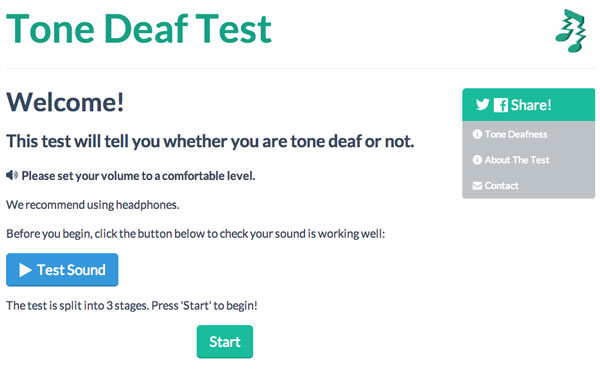 As you’ve probably noticed, we are currently very focused on the issue of tone deafness. Why? Because we believe far too many people miss out on the joy of music-making because they falsely believe themselves to be tone deaf and incapable of becoming a musician.
As you’ve probably noticed, we are currently very focused on the issue of tone deafness. Why? Because we believe far too many people miss out on the joy of music-making because they falsely believe themselves to be tone deaf and incapable of becoming a musician.
This issue has two aspects: the ear and the voice. Although the two are closely related, having good pitch sensitivity is different from being able to sing in tune. It’s important to note that singing out of tune does not mean that you are tone deaf.
We’ve discussed some of the issues and myths around tone deafness, including the varied definitions people have in mind when they use the phrase. Because of this confusion, if you seek out a “tone deafness test” online you might be frustrated by what you find.
On Friday we launched a new interactive tone deafness test which we hope will be a more useful evaluation for those who have concerns about being tone deaf. Give it a try!
Why a new tone deafness test?
As we recently covered here on the site, there are already several tone deafness tests online. However, we found that all of these have drawbacks. Some have technical issues such as using MIDI files or being incompatible with tablets and mobile devices, but the biggest issue is that they aren’t really designed to help people realise they are not tone deaf!
Some of the tests are overly challenging, testing quite sophisticated relative pitch and musical memory skills, rather than the basic pitch sensitivity required to not be “tone deaf”. The best-designed tests we found actually target a rare cognitive disfunction called amusia.
While these tests may be appropriate for neuroscience research and diagnosing extreme musical disfunction, the reality is that the vast majority of people who believe themselves tone deaf have no such biological deficit.
When people say “tone deaf”, what they generally mean is “can’t tell right notes from wrong ones”. Actually, they normally mean “can’t sing in tune”, but that’s a separate issue! As far as the ear is concerned, a “tone deafness test” should be testing basic pitch discrimination ability – and nothing else.
About the Tone Deaf Test
The new test at ToneDeafTest.com consists of three stages, each of which tests your pitch sensitivity in a different way. It begins with the simple question “are these two notes the same or different?” then in part two uses pitch sweeps to test whether you can hear if pitch is moving upwards or downwards. Finally, pairs of notes are used with the question “is the second note higher or lower than the first?”
Three different instrument sounds are used, and the details of the questions are randomised each time. The test is quite thorough, while testing only the core skill of pitch discrimination.

We believe this new test is designed well to ensure that those who are truly tone deaf will be recognised – while those who have the basic ability required to learn to sing in tune and play music well will easily pass the test.
The results so far seem to confirm this. In the 5 days since launch almost 600 tests have been completed and less than 1% of these have been identified as “tone deaf”. We believe this is in line with the number of people who truly have biologically-impaired pitch sensitivity.
Are the 99% of people who pass all excellent musicians? No.
Can they all sing in tune? Probably not!
However, the purpose of this test is to show people that their ears are working properly. From here it’s a matter of:
- Ear training to develop their pitch skills
- Vocal practice to connect their voice to their ears
If you pass the test it doesn’t necessarily mean that you are currently a good musician. However, you can be confident that a bit of practice for your ears and voice are all that’s required to become one.
We’d really appreciate any help spreading the word about this new test. You can take the tone deaf test yourself and please pass the link (ToneDeafTest.com) on to anybody you know who might be interested or in need of reassurance.








